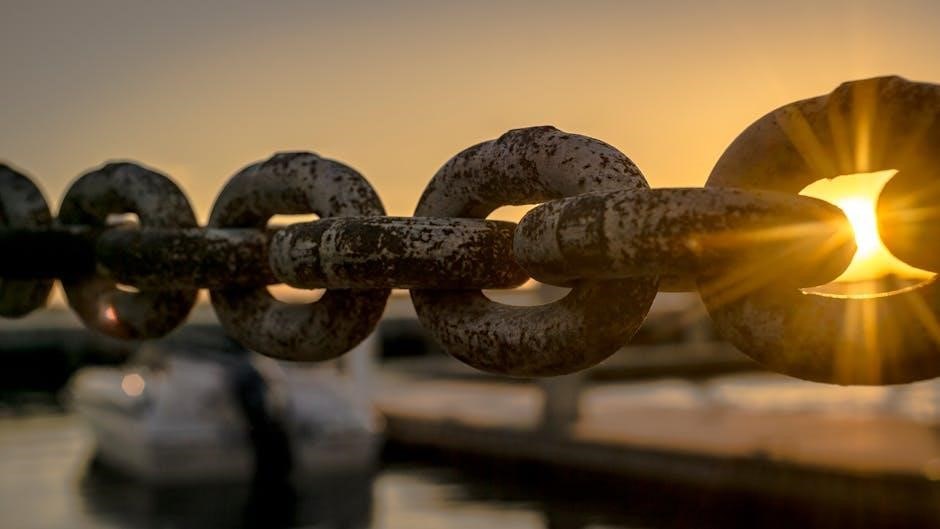Anchoring requires a guide to ensure safety and stability‚ using proper techniques and equipment‚ such as ropes and chains‚ to secure the boat in place‚ with online resources providing helpful tips and information always available online now.
Importance of Anchoring
Anchoring is a crucial aspect of boating‚ as it provides a sense of security and stability‚ allowing boat owners to relax and enjoy their time on the water‚ with many online resources and guides available to help them understand the importance of anchoring and how to do it properly‚ using the right equipment and techniques to ensure a safe and enjoyable experience.
The importance of anchoring cannot be overstated‚ as it helps to prevent accidents and damage to the boat and its surroundings‚ and online forums and discussions often emphasize the need for proper anchoring techniques and equipment‚ such as ropes‚ chains‚ and anchors‚ to ensure a safe and stable experience‚ with many experts and experienced boaters sharing their knowledge and advice on the topic‚ and providing helpful tips and guidance for those who are new to boating or looking to improve their anchoring skills.

By understanding the importance of anchoring and how to do it properly‚ boat owners can enjoy a more relaxing and enjoyable experience on the water‚ with the knowledge and confidence that comes from knowing how to secure their boat safely and effectively‚ using the right equipment and techniques‚ and following the advice and guidance of experienced boaters and online resources‚ to ensure a safe and stable experience for themselves and their passengers.

Types of Boat Anchors
Boat anchors come in various types‚ including fluke‚ plow‚ and mushroom anchors‚ each with its own unique characteristics and uses‚ suitable for different boat sizes and water conditions‚ with online guides available to help choose.
Popular Anchor Types
Some of the most popular anchor types include the fluke anchor‚ which is known for its holding power in sandy or muddy bottoms‚ and the plow anchor‚ which is versatile and can be used in a variety of water conditions. The mushroom anchor is another popular type‚ characterized by its large‚ flat surface area and ability to hold well in soft bottoms. These anchor types are widely used due to their effectiveness and reliability. Online resources provide detailed information on the different types of anchors‚ including their characteristics‚ uses‚ and advantages. By researching and understanding the different anchor types‚ boat owners can make informed decisions when choosing the right anchor for their vessel. Manufacturers also provide guides and recommendations for selecting the appropriate anchor type based on boat size‚ weight‚ and intended use. With the right anchor‚ boat owners can ensure a safe and secure anchoring experience‚ and online resources are available to help guide the decision-making process and provide useful tips and information. Anchors are essential equipment for boats‚ and selecting the right type is crucial for safe and successful anchoring.

Choosing the Right Anchor
Use online guides and manufacturer recommendations to select the correct anchor type and size for your boat‚ ensuring a safe and secure anchoring experience always with proper equipment and techniques in place every time.
Sizing Your Anchor
To determine the correct anchor size‚ consider the length and weight of your boat‚ as well as the windage and water conditions you’ll be anchoring in‚ using online resources and manufacturer guides to make an informed decision.
Most manufacturers provide tables and charts to help you select the right anchor for your boat‚ taking into account factors such as boat length‚ weight‚ and hull type.
By following these guidelines and considering the specific needs of your boat‚ you can ensure that you choose an anchor that is adequately sized to provide safe and secure anchoring.
Additionally‚ it’s essential to consider the type of anchoring you’ll be doing‚ such as overnight anchoring or anchoring in rough waters‚ and choose an anchor that is suitable for those conditions.
With the right size and type of anchor‚ you can enjoy a safe and secure anchoring experience‚ and online guides and tutorials can provide helpful tips and advice to guide you in the process of sizing your anchor.
Using the correct anchor size is crucial for safe anchoring‚ and by taking the time to research and choose the right anchor‚ you can help ensure a successful and enjoyable anchoring experience.
Always consult the manufacturer’s instructions and guidelines for sizing your anchor to ensure you make the right choice for your boat.

Anchoring Techniques
Proper anchoring involves using ropes and chains to secure the boat‚ with various online guides providing helpful tips always available to guide an anchor safely and effectively now online every day.
Setting the Anchor
To set the anchor‚ it is essential to consider the water depth and the type of sea floor‚ as this will affect the anchor’s ability to hold the boat in place‚ with online resources providing helpful guides and tips on how to do this safely and effectively.
The process of setting the anchor typically involves slowly lowering the anchor into the water‚ allowing it to sink to the bottom‚ and then securing the rope or chain to the boat‚ making sure it is tight enough to hold the boat in place.
It is also important to consider the direction of the wind and current‚ as these can affect the boat’s position and the anchor’s ability to hold‚ with some anchors being more suitable for certain conditions than others.
Additionally‚ it is crucial to regularly check the anchor to ensure it is still holding the boat in place‚ and to make any necessary adjustments‚ with the goal of keeping the boat safe and secure.
By following these steps and considering the various factors that can affect the anchor’s performance‚ boat owners can ensure a safe and successful anchoring experience‚ and can enjoy their time on the water with confidence.
The internet provides a wealth of information on anchoring techniques and best practices‚ and boat owners can consult these resources to learn more about setting the anchor and other related topics.